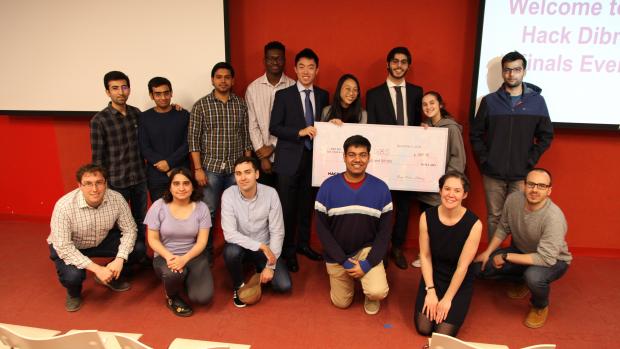Tandon Students “Check Out” How to Improve the User Experience of Dibner Library

Hack Dibner winners, from left to right: Idriss Dimson, Harrison In, Yurou Zeng, Michael Hatoum, Melissa Canavan (Team Dibs), Abhinav Sharma, Utkarsh Prakash (Team Closure).
“People really abuse the current study room booking system,” mentioned Roman Bromblin at yesterday’s Hack Dibner final pitch event. He was addressing the creators of Dibs, a proposed room-booking software for Dibner Library’s private study rooms. “I can’t emphasize enough how desperate the need for something like this is.”
The library’s yearly Hack Dibner event asks Tandon students to enhance the user experience within NYU libraries through technology, considering all realms where it could be applied: in study spaces, while searching for and cataloguing information, and for physical and virtual accessibility and wayfinding.
Idriss Dimson, Michael Hatoum, Harrison In, Yurou Zeng, and Melissa Canavan spent the last three months creating Dibs. Of the eight teams presenting their proposed solutions, their group most impressed the judges. Their thorough research and excellent design earned them a winning 94.6 points out of an available 100. Following the often-repeated axiom of user experience (“You are not the user!”), they asked Dibner librarians and patrons what issues were most pressing to them. Library workers like Roman Bromblin (who in addition to his duties at Dibner is also studying Chemical and Biomolecular Engineering) chimed in with their thoughts on the current state of booking and accessing study rooms, from both an administrative and student standpoint.

From there, the team developed a easy-to-use booking system. Though NYU already implements a browser-based booking system, Dibs makes several improvements to it, including signing in with Shibboleth, NYU’s secure login system, an administrative dashboard that allows librarians to track trends in which rooms are booked at certain times and which accessibility features are in demand.
The judges of the competition applied rigorous standards. Makerspace Founding Manager and Adjunct Faculty Member Victoria Bill wanted to know about the security of the login system, and Senior Lecturer Allan Goldstein asked if the booking system was accessible to users with visual disabilities. Both were questions the team had considered; Team Dibs noted that Shibboleth can function as a secure login page, and that the booking system can be used by a screen reader.
Team Closure (Tandon Computer Science graduate students Abhinav Sharma and Utkarsh Prakash), the runners-up of the competition, proposed a system that would improve the navigability of NYU libraries. Using bluetooth beacon technology, Closure proposed setting up bluetooth beacons around the libraries that would communicate with users’ phones, giving haptic feedback and audible instructions for locating library materials like books, as well as inter-library locations like study rooms and bathrooms.
All eight teams that participated in the competition received support from Dibner in developing, researching, and pitching their ideas, and the first and second place teams won $500 and $200, respectively, for their efforts in making NYU libraries more convenient, comfortable, and accessible.
Annie Brinich
NYU Tandon School of Engineering
Master of Science in Integrated Digital Media, Class of 2019




